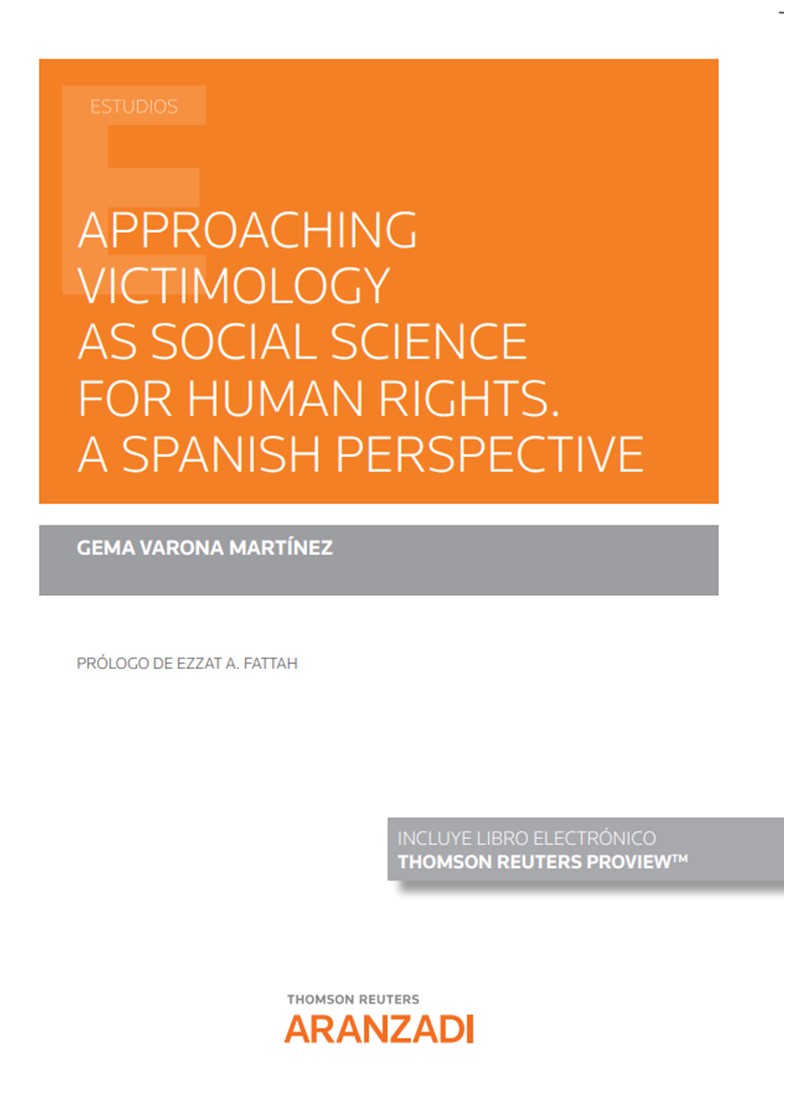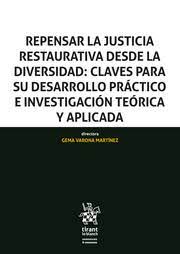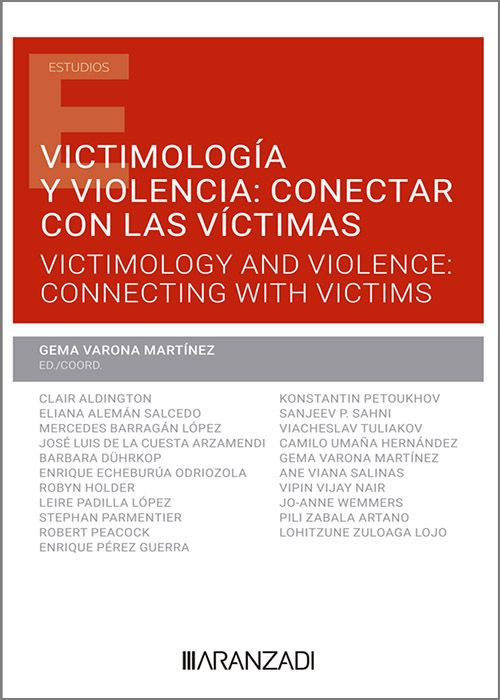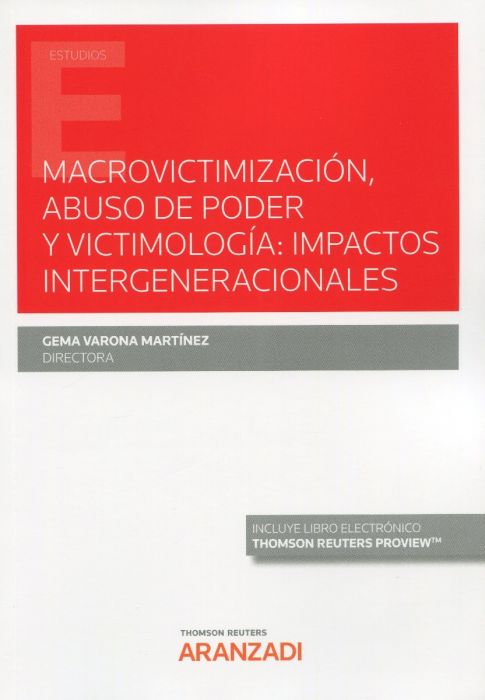Approaching Victimology as social science for Human rights a Spanish perspective
- ISBN: 9788413911472
- Editorial: Editorial Aranzadi
- Fecha de la edición: 2021
- Lugar de la edición: Pamplona. España
- Colección: Estudios
- Encuadernación: Rústica
- Medidas: 24 cm
- Nº Pág.: 423
- Idiomas: Español

Esta obra, prologada por el Profesor E. A. Fattah, recoge los conceptos fundamentales desarrollados para un primer acercamiento académico a la Victimología, proporcionando una serie de herramientas prácticas para su profundización. Parte de un concepto de Victimología como ciencia social profundamente enraizada en una concepción de los derechos humanos y explora las potencialidades de su contribución a las sociedades del siglo XXI.
PREFACE BY PROF. EZZAT A. FATTAH: A SOCIAL SCIENCE FOR TOMORROW. THE PROMISING FUTURE OF VICTIMOLOGY
1.The ever expanding inventory of victimizing behaviours in modern, industrialized societies
2.Future societies will have even greater need for Victimology than present ones as they will be conflict-ridden and rife with victimisation
3.Sadly, the utopian dream of a peaceful, harmonious, egalitarian, and just society has not materialized
4.In tomorrow’s society Victimology will have a major role to play and may eventually become the social science of the time
INTRODUCTION
1.Description and contextualisation
2.Methodology
3.References
I THE SCIENTIFIC CONTRIBUTION OF VICTIMOLOGY IN SPAIN: ORIGIN, EVOLUTION AND CURRENT RESEARCH
1.Introduction to the definition and evolution of Victimology
1.1.What is Victimology?
1.2.Brief history of Victimology as a discipline
1.3.Victimology: What for?
1.4.Victimology: How?
1.5.Victimology in Spain
1.5.1.The legal system, the legal professions and victims
1.5.2.Victimology: the academy and scientific societies
2.Key concepts to recap
3.Thinking Victimology
4.Applying Victimology
5.References
II THE CONCEPT OF VICTIM
1.From positivist typologies to a dynamic conceptualisation
1.1.What is to be a victim?
1.2.Alternatives to the term of victims in relation to victimhood, victimisation and victimism
1.3.Typologies of victimisations beyond victim typologies
1.3.1.Risk and vulnerability
1.3.2.Resistance and recovery
1.3.3.Criminal law typologies
1.4.On the notions of the ideal victim: Why many forms of victimisations and victims are socially (and legally) discarded?
2.Key concepts to recap
3.Thinking Victimology
4.Applying Victimology
5.References
III PUBLIC POLICIES FOR VICTIMS AND THE ROLE OF THE MEDIA: ACTIVISM AND VICTIMISM
1.Victim activism and victim policies
1.1.Victim activism, media and partisan manipulation risk
1.1.1.Some remarks on the major milestones in Spain’s history of victim activism and policy defining the development of its victim rights and services
1.1.2.Victim policy evolution in Spain
1.2.The role of the media in reporting on victims: Portraying and constructing
1.3.Thinking about photojournalists’ role in making severe victimisation visible and reparable: On visual Victimology
1.3.1.On journalists as direct and indirect victims: Vicarious trauma
2.Key concepts to recap
3.Thinking Victimology
4.Applying Victimology
5.References
IV VICTIMISATION AND RECOVERY PROCESSES
1.Explaining the processes of victimisation and devictimisation: The limits of victimological theories
2.Primary, secondary and other definitions of victimisation processes
2.1.The impact of victimisation across time and life dimensions: Throwing a stone into the water or into a window
2.2.Needs of victims
2.3.Typology of victimisation processes, according to time and what causes the harm
2.4.Understanding hidden victimisation
2.5.Secondary victimisation
2.6.How to minimize secondary victimisation
2.7.Resilience and post-traumatic-growth
2.7.1.Key concepts to recap
2.7.2.Thinking Victimology
2.7.3.Applying Victimology
2.7.4.References
V INTERNATIONAL LEGAL STANDARDS AS A RESPONSE TO GENERAL VICTIMISATION
1.International standards: Soft and hard international law
1.1.Universal standards proclaimed by the United Nations
1.2.Council of Europe conventions and recommendations
1.3.European Union legislation
2.Key concepts to recap
3.Thinking Victimology
4.Applying Victimology
5.References
V GENERAL SPANISH LEGISLATION ON VICTIMS’ RIGHTS: THEORY AND PRACTICE
1.Spanish general legislation on victims’ rights
1.1.Law 4/2015 of 27 April 2015: Victims’ rights to protection, information, understand and be understood, accompaniment, support, access to justice and reparation with respect
1.1.1.Right to information
1.1.2.The right to an interpreter and to translation
1.1.3.Victim support services
1.1.4.Victims’ privacy protection
1.1.5.Right to protection
1.1.6.Indirect victims’ rights
1.1.7.Mediation or restorative justice services for victims
1.1.8.Access to justice and participation in the criminal justice system: The official role of victims in the justice system: victim, witness, civil party or private prosecutor
1.1.9.Right to compensation
1.1.10.Intervention with victims at the Crime Victim Support Offices
1.2.Current implementations of the Statute of the Victim in Spain
2.Key concepts to recap
3.Thinking Victimology
4.Applying Victimology
5.References
VII VICTIMS OF INTERNATIONAL CRIMES
1.The notion of an international criminal justice
2.Key concepts to recap
3.Thinking Victimology
4.Applying Victimology
5.References
VIII VICTIMS OF WHITE-COLLAR CRIME, IN PARTICULAR ENVIRONMENTAL CRIME
1.On the concepts of white-collar crime and green Victimology
2.The (cultural, symbolic, structural and yet victimologically and criminally unconsidered) violence inherent in macrovictimisation and abuse of power
2.1.Key concepts to recap
2.2.Thinking Victimology
2.3.Applying Victimology
2.4.References
IX TERRORIST VICTIMISATION
1.The concept of victim of terrorism, its quantification and its legal framework
2.The case study of the Basque Country
2.1.Key concepts to recap
2.2.Thinking Victimology
2.3.Applying Victimology
2.4.References
X VIOLENCE AGAINST WOMEN AND DOMESTIC VIOLENCE
1.International minimum standards
2.Violence against women: A question of human rights and global public health
3.A selection of victimological theories or notions about IPV as violence against women
4.Spain as a model of change
4.1.Intersectionality
4.1.1.How to conceptualize and measure the risk of different women on an individualised basis: individual rights, community and alterity (otherness) in safety assessment
5.A possible discriminatory effect of the global prohibition of mediation in IPV: victim safety versus empowerment? International standards and the Spanish legal option
5.1.Key concepts to recap
5.2.Thinking Victimology
5.3.Applying Victimology
5.4.References
XI SEXUAL VICTIMISATION
1.Understanding sexual victimisation: Incidence, prevalence and diversity of criminalised behaviours and contexts
2.The study case of sexual victimisation in institutional settings: Child sexual abuse in the Roman Catholic Church
3.The relevance of state compensation under the Council of Europe, the European Union and the Spanish legislation
3.1.Key concepts to recap
3.2.Thinking Victimology
3.3.Applying Victimology
3.4.References
XII HUMAN TRAFFICKING
1.Historical background and ideal victims
2.Clarifying concepts in the Spanish legislation
2.1.Smuggling of immigrants
2.2.Human trafficking
2.3.Victim identification, protection, information and reparation
2.3.1.Key concepts to recap
2.3.2.Thinking Victimology
2.3.3.Applying Victimology
2.3.4.References
XIII OTHER VIOLENT VICTIMISATIONS: HOMICIDE, HATE CRIMES AND WORK HARASSMENT AS EXAMPLES OF DIVERSITY IN VIOLENT CRIME AND VICTIM IMPACT
1.Homicide
1.1.Indirect victims, covictims or survivors of homicide
1.2.Missing persons under the suspicion of having being kidnapped or murdered or victims of forced disappearance
1.3.Road traffic-related violent victimisation (negligent homicide and injuries)
1.4.Work conditions related deaths, negligent homicides and corporate crime victimisation
1.5.Hate crime
1.6.Work Harassment
1.6.1.Key concepts to recap
1.6.2.Thinking Victimology
1.6.3.Applying Victimology
1.6.4.General references
XIV CYBER VICTIMISATION
1.Virtual and non-virtual spaces of victimisation and reparation
2.Key concepts to recap
3.Thinking Victimology
4.Applying Victimology
5.References
XV VICTIMS OF CRIMES AGAINST PROPERTY AND VICTIM PREVENTION IN RELATION TO ENVIRONMENTAL CRIMINOLOGY
1.Property crime, fear of crime and victim prevention
2.The model of the local safety audits for any kind of crime: In particular women safety audits
2.1.Introduction: Framing objectives within interdisciplinary critical victimological theory
2.2.Background of Women’s Safety Audits: Connecting theory with women’s grassroots movements in the city
2.3.Development and impact of the so-called maps of fear in the Basque Country within a climate of managerialism and punitivism
2.4.Fear maps uneasy relationship with victimisation and fear surveys
2.5.Critiques of fear maps through the apparent fear paradox in two case studies: Contrasting maps of fear with police data and other social surveys on urban vulnerability
2.6.Final remarks
2.6.1.Key concepts to recap
2.6.2.Thinking Victimology
2.6.3.Applying Victimology
2.6.4.References
XVI HIDDEN VICTIMISATION AND SOCIAL EXCLUSION: HOMELESS PERSONS AS VICTIMS
1.Homelessness and victimisation: Micro, meso and macro perspectives
2.Homeless persons as victims of defensive urbanism policies
2.1.Glocalised order politics for socio-spatial struggles: Transnational security agendas, fear of crime and exclusion of “antisocial” populations in the tourist city
2.2.Urban securitisation informed by broken windows theory and zero tolerance
2.3.The notion of defensive urbanism from an architectural standpoint
2.4.Defensive urbanism in law: categorizing local order through ordinances
2.5.Inclusive versus defensive urbanism: Recovering the legacy of Jane Jacobs
2.5.1.Key concepts to recap
2.5.2.Thinking Victimology
2.5.3.Applying Victimology
2.5.4.References
XVII INNOVATIVE INCLUSIVE FORMS OF JUSTICE FOR VICTIMS: RESTORATIVE JUSTICE AS TRANSFORMATIVE JUSTICE WITH A PROCEDURAL AND THERAPEUTIC PERSPECTIVE OF INTEGRATIVE LAW
1.What is restorative justice?
2.Which are the values guiding restorative justice practice?
3.What are the potential benefits of restorative justice programmes?
3.1.Key concepts to recap
3.2.Thinking Victimology
3.3.Applying Victimology
3.4.References









